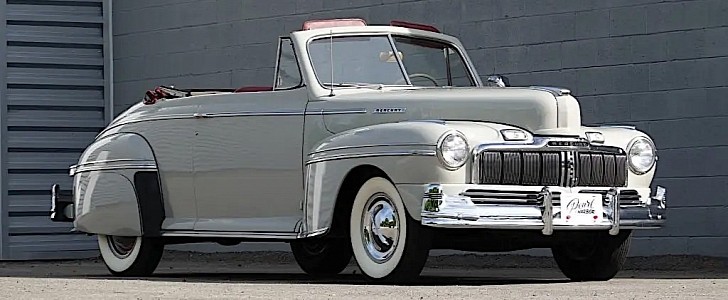Although probably not as many as rival GM, carmaker Ford has its share of skeletons in the closet. One of them is Mercury, a brand that has been around for about seven decades before being sacrificed to the altar of money-saving.
During its time on the market, Mercury was responsible for making vehicles that, in some cases, are still sought after by collectors today. One such vehicle is the iconic Eight, a mid-range machine that came with that irreplaceable feel of classic design, seen on the cars made in the 1940s and 1950s.
The Eight was one of the brand’s heavy hitters and was made in a variety of body styles and rather large numbers. It’s unclear how many of them survive to this day, but if you’re lucky enough to stumble upon one in great condition, expect to pay a fortune for the privilege of owning it.
Lucky or not, we found one, sitting on the lot of cars of a dealer called MaxMotive. It’s a 1947 example, meaning a second generation, and it’s offered, in exchange for $60,750, complete with a very rare and collectible Operator’s Manual.
The car is a convertible, sporting a power-operated burgundy canvas that falls over a gray body and burgundy leather interior with a woodgrain dash.
The long and massive hood, with its flowing lines, moves out of the way to reveal a 239ci (3.9-liter) flathead V8, the only choice for this line of cars during its first two generations. The engine, which shows close to 64,000 miles (103,000 km) of use, is tied to a 3-speed manual transmission, which, in turn, is aided by a 2-speed rear axle.
The car seems to have been very well preserved, but we are not told if some restoration work was performed on it. We only hope that whoever buys it keeps it like this, and doesn’t decide to go for some weird custom.
The Eight was one of the brand’s heavy hitters and was made in a variety of body styles and rather large numbers. It’s unclear how many of them survive to this day, but if you’re lucky enough to stumble upon one in great condition, expect to pay a fortune for the privilege of owning it.
Lucky or not, we found one, sitting on the lot of cars of a dealer called MaxMotive. It’s a 1947 example, meaning a second generation, and it’s offered, in exchange for $60,750, complete with a very rare and collectible Operator’s Manual.
The car is a convertible, sporting a power-operated burgundy canvas that falls over a gray body and burgundy leather interior with a woodgrain dash.
The long and massive hood, with its flowing lines, moves out of the way to reveal a 239ci (3.9-liter) flathead V8, the only choice for this line of cars during its first two generations. The engine, which shows close to 64,000 miles (103,000 km) of use, is tied to a 3-speed manual transmission, which, in turn, is aided by a 2-speed rear axle.
The car seems to have been very well preserved, but we are not told if some restoration work was performed on it. We only hope that whoever buys it keeps it like this, and doesn’t decide to go for some weird custom.


















